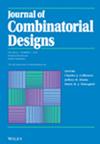Zarankiewicz numbers near the triple system threshold
IF 0.8
4区 数学
Q3 MATHEMATICS
引用次数: 0
Abstract
For positive integers and , the Zarankiewicz number can be defined as the maximum total degree of a linear hypergraph with vertices and edges. Guy determined for all . Here, we extend this by determining for all and, when is large, for all .

接近三重系统临界值的扎兰凯维奇数
对于正整数 m $m$ 和 n $n$ ,Zarankiewicz 数 Z 2 , 2 ( m , n ) ${Z}_{2,2}(m,n)$ 可以定义为具有 m $m$ 顶点和 n $n$ 边的线性超图的最大总度。盖伊确定了 Z 2 , 2 ( m , n ) ${Z}_{2,2}(m,n)$ 适用于所有 n ⩾ m 2 ∕ 3 + O ( m ) $n\geqslant \left(\genfrac{}{}{0.0pt}{}{m}{2}\right)\unicode{x02215}3+O(m)$ 。在这里,我们通过确定 Z 2 , 2 ( m , n ) ${Z}_{2,2}(m,n)$ 适用于所有 n ⩾ m 2 ∕ 3 $n\geqslant \left(\genfrac{}{}{0.0pt}{}{m}{2}\right)\unicode{x02215}3$ 以及当 m $m$ 较大时,适用于所有 n ⩾ m 2 ∕ 6 + O ( m ) $n\geqslant \left(\genfrac{}{}{0.0pt}{}{m}{2}\right)\unicode{x02215}6+O(m)$ 来扩展这一点。
本文章由计算机程序翻译,如有差异,请以英文原文为准。
求助全文
约1分钟内获得全文
求助全文
来源期刊
CiteScore
1.60
自引率
14.30%
发文量
55
审稿时长
>12 weeks
期刊介绍:
The Journal of Combinatorial Designs is an international journal devoted to the timely publication of the most influential papers in the area of combinatorial design theory. All topics in design theory, and in which design theory has important applications, are covered, including:
block designs, t-designs, pairwise balanced designs and group divisible designs
Latin squares, quasigroups, and related algebras
computational methods in design theory
construction methods
applications in computer science, experimental design theory, and coding theory
graph decompositions, factorizations, and design-theoretic techniques in graph theory and extremal combinatorics
finite geometry and its relation with design theory.
algebraic aspects of design theory.
Researchers and scientists can depend on the Journal of Combinatorial Designs for the most recent developments in this rapidly growing field, and to provide a forum for both theoretical research and applications. All papers appearing in the Journal of Combinatorial Designs are carefully peer refereed.

 求助内容:
求助内容: 应助结果提醒方式:
应助结果提醒方式:


